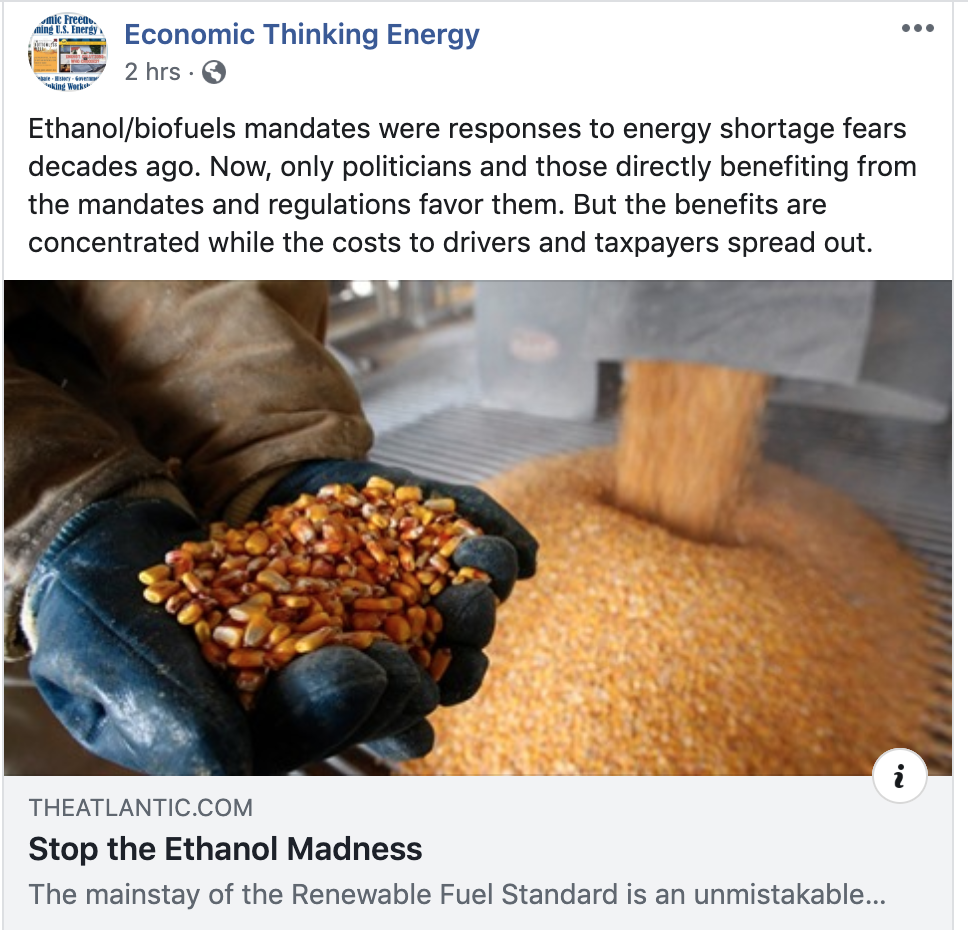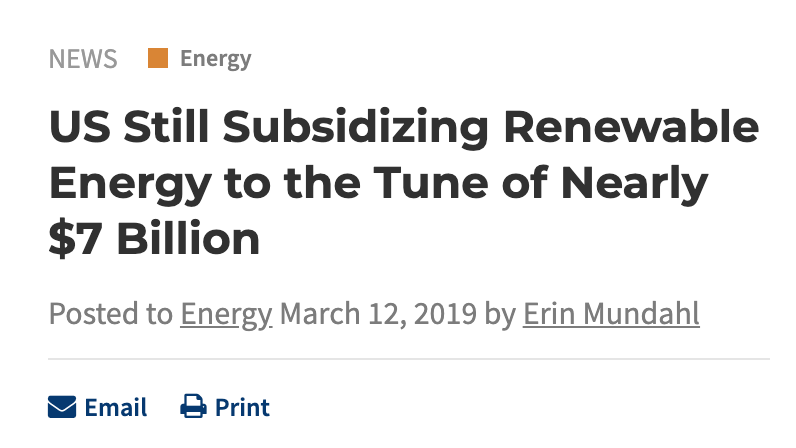End Ethanol/Biofuel and Fossil Fuel Subsidies
My 2018 MasterResource article Environmental Accounting and Green Subsidies: The Biofuels Mistake (December 4. 2018), was written for a World Schools motion calling for “environmental cost accounting.” For this year’s federal energy policy topic, popular affirmatives call for ending ethanol and biofuel subsidies and madates. For example:
• DFW Debate Sourcebook includes: Eliminate Title IX of the Farm Bill and Sun Grant Program.
• Ethos Sourcebook includes: End Ethanol Subsidies
Economic Thinking Energy page (Facebook) recently shared Stop the Ethanol Madness from The Atlantic (November 23, 2019), with this comment:

Ethanol/biofuels mandates were responses to energy shortage fears decades ago. Now, only politicians and those directly benefiting from the mandates and regulations favor them. But the benefits are concentrated while the costs to consumers and taxpayers spread out.
Public Choice Theory is the formal study of why federal programs like ethanol and biofuel subsidies continue year after year, decade after decade. (Costly fossil fuel subsidies continue year after year as well, discussed below)
Stop the Ethanol Madness, subtitled The mainstay of the Renewable Fuel Standard is an unmistakable social and environmental failure. Why does it persist? briefly reviews energy policy history, then notes:
Corn ethanol may well be worse for the climate than fossil fuels, and the program does significant damage to both the economy and the environment. Its sole beneficiaries are large agricultural corporations—and the politicians who serve them.
The fact that the companies that benefit from ethanol and biofuel mandates are few and concentrated is key to the survival of these programs. Those companies and their business associations and lobbyists donate millions each year to federal congressmen and candidates, and all they ask in return is votes to continue subsidies that, though they raise the price and reduce the energy in gasoline, hurt consumers invisibly compared to the clear gain to agribusinesses and ethanol refiners.
The legislation that subsidizes and mandates ethanol also hands out tens of thousands of politicized energy grants, each supported by those who get the money (who then support congressmen voting for the grants). The Missouri Coalition for the Environment, on their Title IX: Energy page (July 11, 2015), explains:
The cornerstone program of the Energy Title is the Rural Energy for America Program (REAP). The program provides grants and loan funding to farmers and small businesses to purchase or install renewable energy systems or make energy efficiency improvements.[2] Over thirty-thousand grants have been handed out through this program since 2012, ranging from $3000 to $72,500,000. While this program has allowed for the creation of many rural solar, wind, hydropower, geothermal projects, and energy efficiency projects, it has also funded the installation of many ethanol blender pumps, anaerobic digesters, and other biodiesel and biofuel installations.
Comparing Renewable Energy Subsidies to Fossil Fuel Subsidies
Comparing and contrasting federal energy subsidies is a challenge but all NCFCA debaters should understand the various programs, policies, arguments, and claims.
An IMF working paper cited in Fossil fuels are underpriced by a whopping $5.2 trillion (Vox, May 17, 2019), argues the lack of a carbon tax on CO2 emissions serves as a subsidy for fossil fuels.
The International Monetary Fund periodically assesses global subsidies for fossil fuels as part of its work on climate, and it found in a recent working paper that the fossil fuel industry got a whopping $5.2 trillion in subsidies in 2017. …
An Environmental Defense Fund blog post looks at different types of subsidy claims in Not all fossil fuel subsidies are created equal, all are bad for the planet ( EDF, June 13, 2019). Separate from the claim that CO2 emissions should be taxed, are smaller but still substantial global “direct subsidies”:
The actual, direct subsidies—money flowing directly from governments to fossil fuel companies and users—are “only” around $300 billion per year. That is still a huge number, and it may well be an underestimate at that. The International Energy Agency’s World Energy Outlook 2014, which took a closer look at fossil subsidies than reports since, put the number closer to around $500 billion; a 2015 World Bank paper provided more detailed methodologies and a range of between $500 billion and $2 trillion.
A link in the article goes to How Clean is “Refined Coal”? An Empirical Assessment of a Billion-Dollar Tax Credit (Resources for the Future, November 11, 2019):
[Abstract] US tax law provides nearly $1 billion annually in tax credits for “refined coal”, which is supposed to reduce local air pollution. Eligibility for the credit requires firms to demonstrate legally specified emissions reductions for three pollutants. Firms typically demonstrate eligibility through laboratory tests, but results from the lab can differ from those in practice. Using a nationally comprehensive boiler-level panel dataset, we find that emission reductions in practice are only about half of the levels required. We also show that the policy reduces social welfare. Because the tax credit is up for reauthorization in 2021, our work has immediate policy relevance.
Public Choice theory helps us understand why this billion dollar subsidy is much like ethanol/biofuels subsidies. Benefits flow to a small number of identifiable companies at the cost of taxpayers, the environment, and perhaps people who inhale extra pollution created.
Debaters can add up the federal subsidies that flow to fossil fuel technologies and companies and compare them to subsidies that flow to renewable energy companies. US Still Subsidizing Renewable Energy to the Tune of Nearly $7 Billion (InsideSources, March 12, 2019) cites the Energy Information Agency (2016):

According to the EIA in 2016, the most recent year for which complete data is available, the federal government spent just shy of $14 billion in energy subsidies and support. Subsidies for renewable energy totaled $6.682 billion, while those for fossil energy totaled a mere $489 million.
Of these subsidies, relatively little came as direct payments to renewable energy products. About 80 percent (or $5.6 billion) of the 2016 renewables subsidies came in the form of tax breaks.
Targeted tax credits tend to distort and delay the technologies (renewable or fossil fuel) they fund, according to the Heritage Foundation.:
“Targeted tax credits have become a popular way for government to award special treatment and artificially attract private-sector interest to politically favored and well-connected industries,” writes Katie Tubb, a policy analyst at The Heritage Foundation. “In short, they’re nothing more than subsidies doled out through the tax code. Not only is this fiscally irresponsible, but Congress also does no service to these energy technologies and companies in the long run by subsidizing them.”
Hundreds of separate companies innovate and advance renewable energy and fossil fuel energy technologies each year. But which are deserving of further engineering time and money? Venture capital companies make mistakes in choosing which companies and technologies to invest in. But they make mistakes with investor dollars not taxpayer dollars.
For more, see The Energy Race Is On (improving fossil fuels vs. political favorites) (MasterResource, August 28, 2018):
Across the world enterprises race to discover and develop new energy-rich places and raw materials, searching for pathways to lower costs, reduce waste, and boost yields. For energy, the master resource, engineers study and innovate solar to oil sands technologies and processes, testing new materials, chemicals, and reactions for transforming sun, wind, water, and earth to energy.
Windmill teams design ever larger, more efficient blades [and kites!], more efficient power transformers, and…more resilient to storms and corrosion. Hopeful articles are published regularly reporting cost and efficiency advances in wind, solar, and energy-storage industries.
But these wind and solar technologies, government-dependent as they are, face stronger competition from teams advancing various hydrocarbon technologies.
End Federal Energy Subsidies
Debaters calling for ending all these energy subsidies, tax credits, and mandates don’t have to take sides on renewable energy vs. fossil fuel debates. They can instead make the case that federal officials and politicians are unlikely to know what energy companies and technologies have the most potential. Judges are unlikely to be supportive of federal energy subsidies and tax credits anymore than they like the idea of federal education subsidies and mandates.
And for anyone who might claim the private sector lacks funds for renewable energy investments, consider Softbank’s planned solar energy program (though now much reduced):
The Japanese investor sought deals of immense scale in Saudi Arabia, India and beyond. He promised to spend hundreds of billions of dollars tackling one of the world’s toughest challenges—meeting its growing energy demand with less carbon-intensive sources.
Today, his boldest proposals are foundering. Mr. Son has announced plans to build as much as 220 gigawatts of solar capacity in Saudi Arabia and India by 2030—equivalent to half of what exists today around the world. Yet SoftBank has managed to contract for around 3 gigawatts in India and has about 700 megawatts in Japan. The company hasn’t completed a project in Saudi Arabia and doesn’t appear close to winning a major contract there soon.
SoftBank’s Bid to Build a Solar-Power Empire Founders (WSJ, August 10, 2019)
Billions of dollars also flow each year to into and out of environmental foundations and organizations that promote renewable energy technologies. Annual incomes for 2012:
The Sierra Club: took in $97,757,678
The Sierra Club Foundation: $47,163,599
The Environmental Defense Fund: $111,915,138
Natural Resources Defense Council: $98,701,707
National Audubon Society: $96,206,883
National Wildlife Federation: $84,726,518
Greenpeace USA: $32,791,149
National Parks Conservation Association: $25,782,975
The Wilderness Society: $24,862,909
Al Gore’s Alliance for Climate Protection: $19,150,215
But those are just the medium sized incomes. Here are some large ones:
The Nature Conservancy: $949,132,306…
Greenpeace International: $406,000,000
Wildlife Conservation Society: $230,042,654
World Wildlife Fund: $208,495,555Cracking Big Green: To Save the World from the Save-The-Earth Money Machine Kindle Edition, March 28, 2018
Of course a lot of these funds are spend in fundraising, public relations, lobbying, and paying journalists to write articles. But still, a significant amount should be available to advance renewable energy technologies.

1 Response
[…] earlier post on fossil fuel and renewable energy subsidies (End Ethanol/Biofuel and Fossil Fuel Subsidies) noted not taxing CO2 emissions from fossil fuel energy has been called a multi-trillion dollar […]